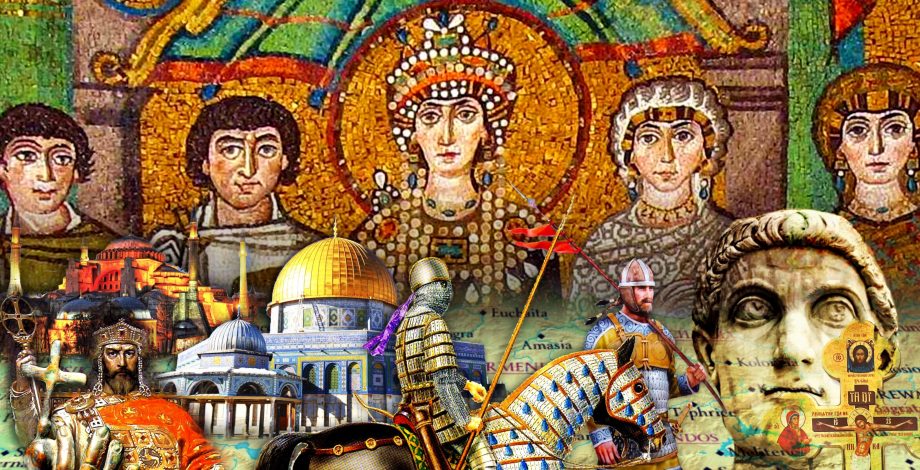
More questions to tackle this week. Comparing the sack of 1204 to the sack of Rome in 410. Questioning the Byzantine system of succession and the routes of their decline. And pondering whether other Emperors rose to power like Alexios Angelos – on the back of a foreign army.
Pic: The Sack of Rome by the Barbarians in 410 by Joseph-Noël Sylvestre, 1890
Stream: Questions XII
Download: Questions XII
RSS Feed: The History of Byzantium
If you want to send in feedback to the podcast:
– Either comment on this post.
– Or on the facebook page.
– Leave a review on Itunes.

Very interesting episode. I love such system analysis.
1) So from 22 emperors 12 were removed from power. But what was % for those born in purple and for those whose fathers were born in purple?
Polish–Lithuanian res publica had elected kings, but if a king had an adult son, in 3 cases from 4 they were elected also. But a huge difference, their power was much smaller than emperors and they didn’t make a law.
2) Trade maybe wasn’t present in ideology of elites, but scale of Constantinople was possible only by trade, but of course if Venetian were not taxed, then for Roman traders was much harder to survive.
3) Better roads means better trade and money, aqueducts means less people dining of diseases. Both important factors in wars, although I guess total urban population in the empire was low.
There was an interesting question and answer about assimilation. Among factors that contribute to assimilation is a matter how intensively people were moved around an imperium, mainly soldiers and bureaucrats, and how difficult it was for people from provincial elites to make a carrier in the capital or other provinces, in this case mainly for Bulgars. So those are my questions for Questions XIII. I remember once there was a citation from a source when Athenians were described with great contempt.
I particularly appreciated the discussion comparing the dynamics in Byzantium with Europe. Especially contrasting the oath-driven perspective of the western knights (even if they did try to wiggle on the hook a lot) vs. the politically pragmatic approach of the Byzantines and their greater willingness to switch directions politically. The more I think about that the more it seems to me to explain some of the frequent culture clashes that occurred between the two groups.
Hi Robin! I started listening to this back in August and have finally caught up with you today. Absolutely fantastic show – I love the amount of research you do and how well you present it. Only disappointment is that now I have to wait for new episodes.
One question about the Latins/Knights and their perception in Byzantium – you mentioned that the Romans, even Choniates, had a grudging respect and admiration for the Latins and their bravery. Manuel Komnenos also seems to have hung out with a lot of Latins and demonstrates some very un-Basileus but western knight-like qualities of personal bravery in battle (including that story about him being scolded by John for being reckless when he attacked Turks to rescue some troops). Were these Knights/western ideals popular in the circles of the other aristocrats and noblemen in Byzantium too? And were there any notable Romans who actually tried to emulate such qualities in battle?
Yes the aristocratic males of the Byzantine court were all horsemen who had similar values as the Latin Knights. They definitely tried to match or better the Latins. We saw this at Antioch when Manuel arranged a tourney and encouraged his associates to show off their skills. In battle things get a little trickier to compare. Obviously 2 centuries earlier Nicephorus Phokas developed his own heavy cavalry squads who would have been similar to Latin Knights. But by the Komnenian period it was simpler to hire Latins to do this rather than risk Byzantine troops in such expensive and risky ventures.
Finally getting caught up Robin and I wanted to leave a comment on the succession.
One of the Roman Empire’s neighbors suffered similar problems at a similar time: Venice.
A list of the Doges of Venice is replete with figures deposed, blinded, or tonsured for a variety of reasons. You also had a strong mercantile economy with many powerful clans wanting to see their family in the top position.
Beginning in the 12th Century, however, the Venetians begin to create increasingly elaborate election procedures as well as resting more power in institutions that shared power among the nobility like the Council of Ten, with the Doge functioning as a first among equals and later as mere figurehead.
Perhaps before the Komnenian system such a shared power system might have taken hold among the Roman elite.